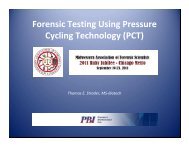PCT News Discovery Starts With Sample Preparation - Pressure ...
PCT News Discovery Starts With Sample Preparation - Pressure ...
PCT News Discovery Starts With Sample Preparation - Pressure ...
Create successful ePaper yourself
Turn your PDF publications into a flip-book with our unique Google optimized e-Paper software.
P C T N e w s<br />
<strong>Discovery</strong> <strong>Starts</strong> <strong>With</strong> <strong>Sample</strong> <strong>Preparation</strong> TM<br />
Volume 3, Issue 6 June 2009<br />
Excerpt from PBI Poster<br />
Presented at the 2009 ASMS<br />
Proteomics Under <strong>Pressure</strong>: rapid<br />
extraction and digestion in a single tube<br />
ALEXANDER V. LAZAREV1; Emily Freeman2; Vera S.<br />
Gross1; Greta Carlson1; Edmund Ting1; Alexander R.<br />
Ivanov2. 1<strong>Pressure</strong> BioSciences, South Easton, MA ;<br />
2Harvard School of Public Health, Boston, MA<br />
Introduction<br />
Hydrostatic pressure has been previously shown to enhance<br />
enzymatic hydrolysis by trypsin [1, 2], chymotrypsin and<br />
pepsin [3, 4], as well as by Alcalase, Neutrase, Corolase 7089,<br />
Corolase PN-L, and papain [5, 6]. In our preliminary<br />
experiments, we have confirmed the positive effects of<br />
pressure and additional benefits of alternating hydrostatic<br />
pressure (pressure cycling technology, or <strong>PCT</strong>) for several<br />
enzymes including proteinase K, PNGase F, Lys-C and<br />
lysozyme. However, the mechanisms of pressure-induced<br />
acceleration remain speculative, and the influence of various<br />
chemical agents on enzymatic activity, substrate conformation<br />
and efficiency of the digestion process are not well<br />
understood, which leads to great variability of experimental<br />
results between groups which have attempted to employ <strong>PCT</strong>enhanced<br />
digestion methods.<br />
The <strong>Pressure</strong> Cycling Technology <strong>Sample</strong> <strong>Preparation</strong> System<br />
(<strong>PCT</strong> SPS) applies alternating hydrostatic pressure between<br />
ambient and ultra high levels to control molecular interactions<br />
[7]. The <strong>PCT</strong> SPS has been successfully used in a variety of<br />
applications, including cell and tissue lysis, and the extraction<br />
of proteins, lipids and nucleic acids [8]. Recently, <strong>PCT</strong> has also<br />
been shown to accelerate enzymatic reactions such as<br />
proteolysis [1]. The <strong>PCT</strong> SPS (Figure 1) is comprised of a<br />
small, semi-automated bench-top instrument (Barocycler<br />
NEP3229 or NEP2320) and single-use sample processing<br />
containers called PULSE Tubes (<strong>Pressure</strong> BioSciences, Inc.,<br />
South Easton, MA). Used together, the PULSE Tubes<br />
transmit the pressure generated by the Barocycler to the<br />
sample, resulting in pressure enhanced proteolysis and<br />
accelerated genomic DNA isolation.<br />
<strong>PCT</strong> MicroTubeTM Adapter Kit*<br />
for<br />
<strong>Pressure</strong>-Enhanced Enzymatic Proteolysis<br />
See Brochure<br />
with Data and Comments from<br />
Thermo Fisher, FDA, NYU School of Medicine, Mississippi<br />
State University and<br />
Harvard School of Public Health<br />
In this work we explore the stability and catalytic activity of<br />
trypsin and chymotrypsin under the influence of several<br />
chaotropes and organic solvents in combination with<br />
hydrostatic pressure and elevated temperatures. We have<br />
employed chromogenic substrates in order to measure<br />
enzyme activity independent of pressure-induced changes in<br />
substrate protein conformation. Additionally, using high<br />
performance LC-MS analysis, we have tested the effect of the<br />
factors outlined above on efficiency, selectivity, and throughput<br />
of proteolytic digestion. Analysis of the data obtained thus far<br />
leads to a set of guidelines for development of optimized and<br />
highly reproducible pressure-enhanced digestion methods.<br />
Continued on Page 3<br />
www.pressurebiosciences.com












